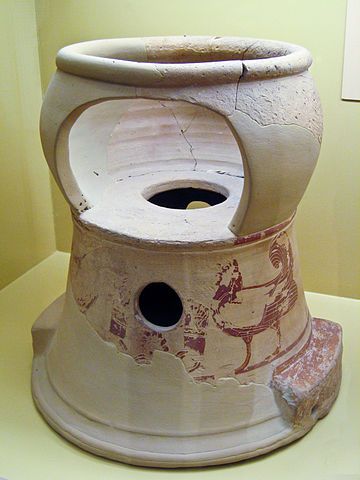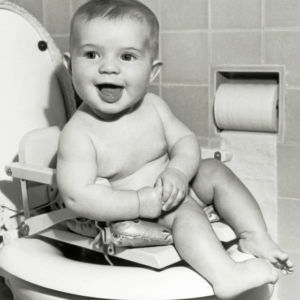Zindelijk overdag
Potty training during the day
Children are born with an instinct not to soil themselves, just like most other animals. Immediately after birth, a baby communicates with us. Because he/she is hungry, cold, tired, or needs to urinate or defecate. We, as humans, will in most cases choose to put a diaper on the baby immediately after birth and change it when it is full or we think it's time. However, if you pay close attention to your baby's signals, you can have your child pee and defecate on/above a potty at a very young age. Research has shown that newborn babies already have neural pathways linked to bladder control. Also, EEGs (an electroencephalogram or a brain film) in newborn babies have shown that there is more cortical secretion when the bladder fills. This indicates that newborn babies already have a central involvement in urination. It is no exaggeration to say that a baby is, in fact, born potty trained. When we put an ultra-fast absorbing disposable diaper on the baby, a child will quickly lose the connection with his body. The nappy feels dry before urinating, during urination and after urination. There is little or no feedback for the child and innate toilet training is not supported or promoted, but rather unlearned or at least ignored.
If you put a reusable cloth diaper on your child made of a natural material, the diaper will feel wet when a child urinates and will remain moist afterwards. With a new pee, the diaper becomes warm and wet again and the very young baby feels that something is happening underneath. One baby will find that more annoying than the other baby and some of the babies will cry because they are wearing a wet or dirty diaper. These babies (and all other babies) can be very helpful with Baby Potty Communication, where you try to pay close attention to your baby's signals and regularly hold the baby over a potty or toilet.
When we have put the baby and toddler in a nappy, there will come a moment when we will help the child to become potty trained. You can call that potty training, but all the elements to become or be potty trained are already present in the child. I prefer to call it helping with potty training.
In Western countries, the average age of toilet training has risen dramatically in recent decades. For example, the average toilet-training age was only 18 months around 1940, where it is now around 35 months (girls) and 39 months (boys). That's a difference of 1.5 years! There are several explanations for this. If we go a little further back in time, potty training was usually hard 'trained' at a very young age. In the 1920s and 1930s, parents were advised to put a bar of soap in their child's anus at regular intervals in order to enforce absolute regularity of bowel movements. That would promote cleanliness. At that time it was also normal to scold or physically punish in case of accidents. After the Second World War, these coercive methods were seen as harmful and it was not recommended to "train" children in such a coercive way. But even after these changes in advice, children around the 1950s were still fully potty trained between 18 and 24 months. Between the 1950s and 1980s, the disposable diaper became increasingly better, cheaper and therefore more common. At the same time, the age at which children were potty trained started to move further and further. A study from the 1980s found an average age of daily toilet training between 24 and 27 months. In the 1990s, another study found that only 50% of 36-month-olds were potty trained. Various studies link the use of disposable diapers, but also the fact that parents both work more and more often and children are more often at day care, are mentioned as explanations for the major delay in the toilet training process.
Unfortunately, there are virtually no recent studies comparing the modern reusable diaper and the disposable diaper in a study of toilet training, or any other subject for that matter. It seems that children in reusable nappies are still generally potty trained sooner than children who wear disposable diapers. A possible explanation for this is the wet feeling of a reusable diaper, which keeps a child more aware of his/her urination behavior.

Greek potty, 6th century BC
How can you best help your child become toilet trained?
Most scientific studies agree that starting the potty training process on time leads to earlier toilet training and fewer problems with bedwetting later in life. The limit is often referred to as 24 months.
A recent study with 13,500 babies in China showed that starting toilet training very early has a negative effect on the use of disposable diapers. In other words, the children use much less disposable diapers and are much sooner toilet trained if the process of toilet training is supported very early. More than 8% of two-year-olds still wore disposable diapers, and only 0.7% of six-year-olds. A higher disposable diaper use correlated with an urban living environment and a higher educational level of the parents, but also with a later start of toilet training. In China, the use of disposable diapers is less common than in Western countries. Many parents practice Baby Potty Communication or Elimination Communication with their often very young babies. The study done on 13,500 Chinese children showed that such an early start has a beneficial effect on the age of potty training. Other studies also show that starting toilet training early usually leads to children who are toilet trained earlier, without negative consequences for bladder function. The process of toilet training generally takes a little longer, but the age at which complete toilet training is reached is lower. The Chinese study showed a clear difference between children who were helped to become potty trained before 12 months, versus those who started after 12 months. The second group depended on disposable diapers for longer.
In Western countries Baby Potty Communication is not done very much and starting the process of potty training early is not widespread either. In the Netherlands, the majority of parents only start when children are more than two years old. On average, Dutch children are potty trained between the ages of 2.5 and 3 years, although 25-30% of children are not toilet trained until after the age of four. This can lead to problems for children themselves, as well as for parents and teachers. In many Asian and African countries, children are potty trained much earlier, presumably because of the Baby Potty Communication that is the standard in these countries. If you are considering doing Baby Potty Communication with your baby, it is worth reading about it. It goes too far in this blog to do full justice to the wonderful idea behind Baby Potty Communication. However, it also requires a lot of time, attention and presence of parents and is not easily feasible for every family.
Practical tips to help your child become potty trained
Apart from Baby Potty Communication, there are various methods to help a child. And a mix of all methods often works well too! It does not really matter how old your child is when you start, if you start a little earlier the process may take a little longer, but your child will probably be potty trained at a relatively young age.
Some basic tips:
- Choose the right moment. Do not start if your child is ill (even if it has constipation or diarrhea), make sure that you have time/rest to be able to invest a lot of time in the project for a few days. Don't start when there are big changes coming up, such as a move, death (if you can see that coming), or the birth of a sibling. It is also useful not to start if your child is just entering a very rebellious phase. Better wait then.
- It is useful if your child can sit upright independently. It is even easier with a child who can walk on his own.
- Prepare for it. Don't have a potty at home yet; Then go buy a potty (or several) with your child.
- Place potties in various places and tell your child what it is for. You can also use them during play, for example if the doll has to pee!
- Talk to your child. Tell them about a wet or dirty diaper, possibly take your child with you when you go to the toilet yourself and explain what you are doing.
- Provide comfortable clothing. The easier it is on and off, the better. The bare buttocks method also works very well, but then it should not be too cold.
- Make it fun and keep it fun. Don't punish your child for an accident, reward for success.
Various methods
There are various well-defined methods to get children potty trained. From potty trained-in-one-day to very gradual potty training. The methods described below have been extensively put on paper by the respective inventors and are well framed. Of course you can also color outside the lines or create your own coloring page.
Potty trained in one day
In this method, the emphasis is on role-playing, offering lots of drinks and staying in sight of the potty at all times. You make sure that your child stays in the space of the potty and you also stay with it. In warm weather this can also be outside. First you play with a doll, who goes on the potty, relieves herself there and is then rewarded. The doll actually lets you drink and pee. If the doll does have a wet diaper, the doll will still be placed on the potty to show that the potty needs to be urinated on (over-correction). When your child understands these steps with the doll, you will repeat these steps with your child. Often this first phase takes about an hour. Let your child drink a lot and ask about every 15 minutes if your child needs to urinate. Help your child on the potty and reward success with compliments. In the event of an accident in the diaper or on the floor, you still put the child on the potty, so over-correction. The success rate of this method varies and depends on the age of your child and the preparation and dedication of the parent.
Child lead
With this method you do everything at your child's pace and only when your child indicates it. If your child is interested in potty training, you and your child will buy a potty. You encourage your child to sit on this, fully clothed. Make it fun and don't put too much pressure on it. Once the child has been using the potty for a few weeks, remove the diaper and ask the child to sit on the potty. Don't insist if the child doesn't want to. Show the function of the jar. For example, you can place the stool from a dirty diaper in the potty and then empty the potty into the toilet. As a parent, you ensure that there are potties in various places in the house and that your child can easily reach them. Encourage your child to go around without a diaper. If children do not start using the potty quickly, you can ask as a parent whether your child might need help. The moment of the first successful urination or defecation in the potty must come spontaneously. Children should feel that using the potty is their own idea. You will only take the last steps, such as emptying the potty and flushing the toilet, with your child if the child is interested in this. This way of potty training often takes a relatively long time and is very child dependent. Average daily toilet training using this method was found to be around 34-38 months in a recent study.
Parent initiated and gradual
Actually, this is a combination of the gradual child-following method, but initiated by the parents, as in the fast potty trained in one day method. You can approach this in various ways. You can possibly prepare this by buying a potty together with your child and letting your child sit on it now and then with clothes on. Only when that feels familiar to a child, do you start using the potty. Make sure your child wears comfortable clothes that can be taken off quickly. In the bare buttocks you can also if it is warm enough. Try to pay attention to your child's signals that he/she needs to urinate or defecate. Ask if your child wants to go on the potty, take off the diaper and help your child on the potty. Reward success immediately, with a compliment, affection, or a sticker, for example. If it is not possible, let your child sit for a maximum of 5 minutes and only if the child wants to. As soon as your child wants to get up, let him/her get up. Give a reward for trying and try again later. With this method it is important to always place your child on the potty on time. If you find it difficult to pick up on the signals, you can put the child on the potty 45 minutes after a drink, and/or two hours after the last pee. To collect stool on the potty, you can put a child on the potty after a large meal and/or 24 hours after the last stool. Do not put your child on the potty too often a day and do not do this more than 100 times in total. At some point you will replace putting it on the potty with reminders. Ask your child if he/she needs to urinate. Always stay positive and optimistic. After at least 10 successful potty moments you can start introducing underwear. Bring this as a reward, for doing so well, and let your child choose their own underwear. In the event of an accident, change your child as soon as possible, so that your child gets used to clean, dry clothes.
With this method it can be helpful to let your child drink a lot, so that there are many practice moments. Make sure that potties are easily accessible and available in various places. Be sure to show affection and praise your child regularly. The potty training process can sometimes be daunting for your child. Let him/her know that you are confident and that you love him/her.
The bare buttocks method
With this method, you let children from the age of 30 months walk around naked near a potty. Provide relatively few distractions, preferably choose an enclosed/demarcated space and offer your child plenty to drink. Let your child figure out how that works with such a potty, but you are present in the same room. Accidents end up on the floor. So do this in the garden in the summer, or in a room with an easy-to-clean floor. Stay affectionate and positive, and don't grumble when you're cleaning up an accident.
Your own way

It goes without saying that you can find your own way, and compile your own method from various reasonably well-defined, described methods. Maybe just different for every child too. We now have four potty trained children. As parents, we initiated the process with all children. At the age of 18-24 months we have placed potties with all children and explained that they can pee and defecate in them. Of course we did not buy new potties for all four children, but we always involved the children in the process of choosing their favorite potty and where to put it. We never put the children on the potty dressed, but always made it clear immediately what a potty is for.
We took the diaper off immediately on the first day. In warm weather always bare bums, in colder weather jogging pants, loose leggings, tights or cheerful leg warmers. Most children immediately understood what the intention was and did their needs on the potty from day 1. The eldest took this very far, by indicating on the evening of the first day that he was now not going to put on a diaper in bed. He was 2 years and a few days. Even at night it was dry from the very first moment. One child took a little longer than the other, but they were all day toilet trained between 20 and 30 months. And so proud of every child! The nights are now also diaperless here, but more about night cleanliness later!
A relapse
It is quite normal that your child does (almost) all the pee on the potty for a while, but then suddenly has many accidents again. Such a relapse is quite normal. Sometimes out of rebellion, sometimes because of stress or changes in the family. Stay positive and affectionate and keep having confidence. If you feel that it is really too early, or your child is getting too stressed out, you can let go and try again in a few months. It will really come back on its own!
Written by Ilka, owner Nappy's.nl









